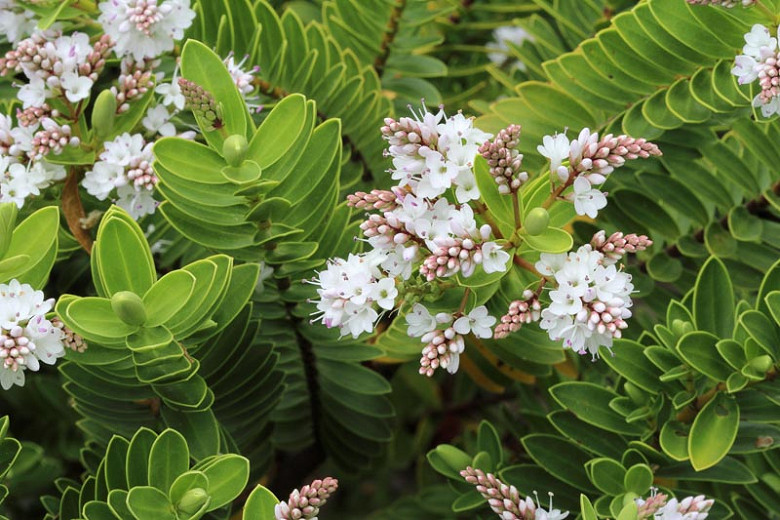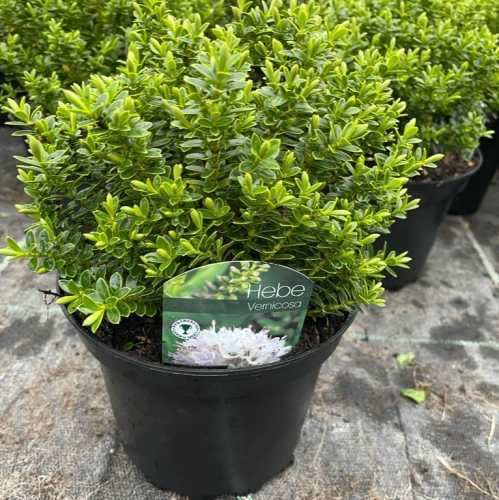Hebe Vernicosa: The Easytogrow Shrub That Will
Hebe Vernicosa: The Easy-to-Grow Shrub That Will Brighten Up Your Garden
Hebe vernicosa, commonly known as varnished hebe, is a small, bushy, evergreen shrub that is native to New Zealand. It is prized for its glossy green leaves and white and pale blue flowers, which bloom in the summer months. Varnished hebe is a relatively easy plant to grow and care for, making it a good choice for gardeners of all skill levels.
Features and Benefits
Varnished hebe is a versatile plant that can be used in a variety of settings. It is often planted in borders, rock gardens, or as a container plant. Varnished hebe can also be used as a hedge or screen.
Here are some of the features and benefits of varnished hebe:
- Easy to grow: Varnished hebe is a low-maintenance plant that is tolerant of a variety of conditions. It can be grown in full sun or partial shade and in a variety of soil types.
- Evergreen: Varnished hebe is an evergreen plant, which means that it will retain its leaves year-round. This makes it a good choice for gardens that need to provide year-round interest.
- Attractive flowers: Varnished hebe blooms in the summer months with white and pale blue flowers. The flowers are borne in spikes and are a popular source of nectar for bees and butterflies.
- Drought tolerant: Varnished hebe is drought tolerant once established. This makes it a good choice for gardens in hot, dry climates.
- Salt tolerant: Varnished hebe is salt tolerant, making it a good choice for gardens near the coast.
How to Grow and Care for Varnished Hebe
Varnished hebe is a relatively easy plant to grow and care for. Here are some tips:
- Plant varnished hebe in full sun or partial shade.
- The soil should be well-drained.
- Water varnished hebe regularly, especially during the first year after planting.
- Fertilize varnished hebe once a year in the spring with a balanced fertilizer.
- Prune varnished hebe in the spring to remove dead or damaged branches and to shape the plant.
Varnished Hebe Pests and Diseases
Varnished hebe is generally resistant to pests and diseases. However, it can be susceptible to scale insects and mealybugs. If you notice any pests or diseases on your varnished hebe, treat them immediately with an insecticidal soap or neem oil.
Conclusion
Varnished hebe is a beautiful and easy-to-grow shrub that can add a touch of elegance to any garden. If you are looking for a low-maintenance plant that will provide year-round interest, varnished hebe is a great option.
If you're looking for a low-maintenance, evergreen shrub that will add beauty and interest to your garden, then you may want to consider Hebe vernicosa, also known as varnished hebe. This versatile plant is perfect for a variety of settings, from small urban gardens to large coastal landscapes.
Varnished hebe is a compact plant that typically grows to 2 feet tall and wide. It has glossy, dark green leaves that are edged in yellow. In late spring to early summer, the plant produces clusters of small white or pale blue flowers.
Varnished hebe is easy to grow and care for. It prefers full sun or partial shade and well-drained soil. It is drought-tolerant and salt-tolerant, making it a good choice for gardens in hot, dry climates or near the coast.
If you're interested in learning more about varnished hebe, I recommend visiting Garden Wiki. This website has a wealth of information about the plant, including its history, care requirements, and pest and disease resistance. You can also find photos of varnished hebe in different settings and learn about where to buy it.
FAQ of hebe vernicosa
- What are the best growing conditions for Hebe vernicosa?
Hebe vernicosa is a hardy shrub that prefers full sun and well-drained soil. It can tolerate some light shade, but will not flower as well in these conditions. The soil should be slightly acidic, with a pH of 6.0-6.5. Hebe vernicosa is drought-tolerant once established, but should be watered regularly during the first year after planting.
- How do I propagate Hebe vernicosa?
Hebe vernicosa can be propagated by softwood cuttings in the spring or summer. Take cuttings from healthy, non-flowering stems that are about 5 inches long. Remove the lower leaves and dip the cuttings in rooting hormone. Plant the cuttings in a well-draining potting mix and keep them moist. The cuttings should root in about 4-6 weeks.
- What are some common pests and diseases that affect Hebe vernicosa?
The most common pests that affect Hebe vernicosa are aphids, scale insects, and mealybugs. These pests can be controlled with insecticidal soap or neem oil. Hebe vernicosa is also susceptible to powdery mildew and rust. These diseases can be prevented by watering the plant in the morning so that the leaves have a chance to dry before nightfall. If the plant does get infected, you can treat it with a fungicide.
- When should I prune Hebe vernicosa?
Hebe vernicosa can be pruned in the spring or fall. Pruning will help to keep the plant compact and encourage new growth. You can also prune to remove any dead, diseased, or damaged branches.
- How can I care for Hebe vernicosa during the winter?
Hebe vernicosa is hardy to USDA zones 8-10. In colder climates, the plant may need to be protected from the cold. You can do this by covering the plant with a burlap sack or placing it in a sheltered spot. Hebe vernicosa will also benefit from a light application of mulch around the base of the plant.
Image of hebe vernicosa
5 different images of Hebe vernicosa from Pinterest:
- A close-up of the flowers of Hebe vernicosa, which are white with a purple center.

- A full plant of Hebe vernicosa, showing its small, dark green leaves and white flowers.

- A Hebe vernicosa plant growing in a pot, with its trailing stems cascading over the edge.

- A Hebe vernicosa plant in a garden, surrounded by other flowers.

- A Hebe vernicosa plant in full bloom, with its flowers covering the plant.

Post a Comment for "Hebe Vernicosa: The Easytogrow Shrub That Will"